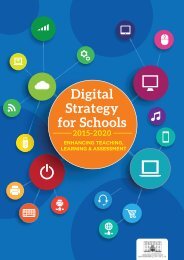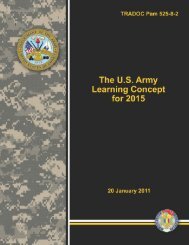Digital Strategy for Schools
TKmc0
TKmc0
Create successful ePaper yourself
Turn your PDF publications into a flip-book with our unique Google optimized e-Paper software.
5. THEME 4: ICT INFRASTRUCTURE<br />
CLOUD SERVICES<br />
This <strong>Strategy</strong> recognises that the cloud computing ecosystem is trans<strong>for</strong>ming how many schools<br />
operate. There are new opportunities <strong>for</strong> teachers, learners, parents/guardians and other<br />
organisations to interact with one another to ultimately support learning. The growth in cloud<br />
services is enabling schools to provide email and file storage space to teachers and learners.<br />
It is allowing them to collaborate and communicate more easily using a range of cost-effective<br />
applications and technologies.<br />
The integration of cloud services, underpinned by fast reliable broadband, has the potential to<br />
enhance linkages between home and school and facilitate internet access “anytime, anywhere”<br />
<strong>for</strong> teaching, learning and assessment resources and activities. The <strong>Strategy</strong> recognises that cloud<br />
services will continue to expand and that the effective use of these services has the potential to<br />
trans<strong>for</strong>m teaching, learning and assessment activities in schools. However, data security and<br />
privacy issues must be considered when using cloud services and schools need greater support in<br />
this area.<br />
TECHNICAL SUPPORT AND MAINTENANCE<br />
<strong>Schools</strong> require external technical support in relation to their ICT equipment, infrastructure and<br />
systems so that they can support teaching, learning and assessment as well as the school’s<br />
administration and planning systems. The issue of technical support cannot be considered as an<br />
isolated issue and should be considered as part of each school’s eLearning plan.<br />
During the <strong>for</strong>mulation of the <strong>Strategy</strong>, schools identified the challenge of attaining reliable and<br />
timely technical support as a major issue. In addition, schools have very diverse needs in terms of<br />
technical support, requiring providers to have a high level of technical knowledge and expertise that<br />
is relevant to different school settings or contexts.<br />
There is no international consensus on any one model of best practice <strong>for</strong> technical support provision.<br />
Models of technical support include specific ICT related grants, the provision of regional technical<br />
support services including technicians (either in school or shared between schools), and provision<br />
of fully managed technical support services (remotely or onsite). A centralised national system of<br />
support is not viable and would not meet schools’ needs because the variation in school location,<br />
size and ICT infrastructure makes such provision impractical. The issue of providing technical<br />
support to all schools is complex and requires further consideration. The <strong>Strategy</strong> will evaluate a<br />
number of technical support options with a view to providing guidance on the best technical support<br />
solutions <strong>for</strong> schools.<br />
PURCHASING AND PROCUREMENT<br />
The Census Report highlights the need to have national arrangements in place <strong>for</strong> the purchase<br />
and supply of school-ready ICT equipment and develop a national plan <strong>for</strong> equipment renewal and<br />
avoiding equipment obsolescence.<br />
As part of the Department Re<strong>for</strong>m Initiative the <strong>Schools</strong> Procurement Unit (SPU) was set up under<br />
the Shared Services Plan 2014-2016. It is hosted by the Joint Managerial Body (JMB) and seeks<br />
43




